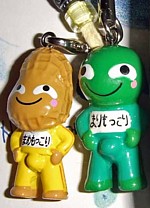
Fresh on the Akita prefecture promotional gimmick scene is a unique and decidedly male mascot modeled after the region's famed kiritampo grilled rice cake skewers. "Kirichimpo" (kiri means "cut" and chimpo is slang for the male organ), a lovey-eyed kiritampo stick with a conspicuous protuberance dangling from its lower end, is the brainchild of Fruru Co., Ltd., an Akita-based souvenir designer and wholesaler.
 The company came up with the idea for Kirichimpo last year after witnessing the far-reaching success of Marimokkori, a happy, well-endowed green monster mascot from Hokkaido, whose name is a play on the words marimo (a type of giant algae ball found in Lake Akan) and mokkori ("erection"). Marimokkori's popularity extends far beyond Hokkaido's shores, to as far away as Chiba, the home of his younger peanut-headed cousin named Mamemokkori (mame means "bean"), and Tokyo, where mounds of the popular Marimokkori can be found inside UFO Catcher claw vending machines at game centers.
The company came up with the idea for Kirichimpo last year after witnessing the far-reaching success of Marimokkori, a happy, well-endowed green monster mascot from Hokkaido, whose name is a play on the words marimo (a type of giant algae ball found in Lake Akan) and mokkori ("erection"). Marimokkori's popularity extends far beyond Hokkaido's shores, to as far away as Chiba, the home of his younger peanut-headed cousin named Mamemokkori (mame means "bean"), and Tokyo, where mounds of the popular Marimokkori can be found inside UFO Catcher claw vending machines at game centers.
While Kirichimpo has yet to rise to Marimokkori status, it appears to be enjoying a measure of success. Last year's initial shipment of 6,000 Kirichimpo keychains sold out in a matter of months. And with demand still strong, the company is rolling out a Kirichimpo ear pick and other new gimmicks, which are soon to appear at souvenir shops and train stations throughout Akita prefecture at a price of 350 yen ($3) each.
[Source: Akita Keizai Shimbun]

 For mobile gamers in western Japan, a hearty seafood dinner awaits just a few key clicks away, thanks to a unique new cellphone fishing game that rewards successful players with home deliveries of fresh, real-world fish.
For mobile gamers in western Japan, a hearty seafood dinner awaits just a few key clicks away, thanks to a unique new cellphone fishing game that rewards successful players with home deliveries of fresh, real-world fish. 





















